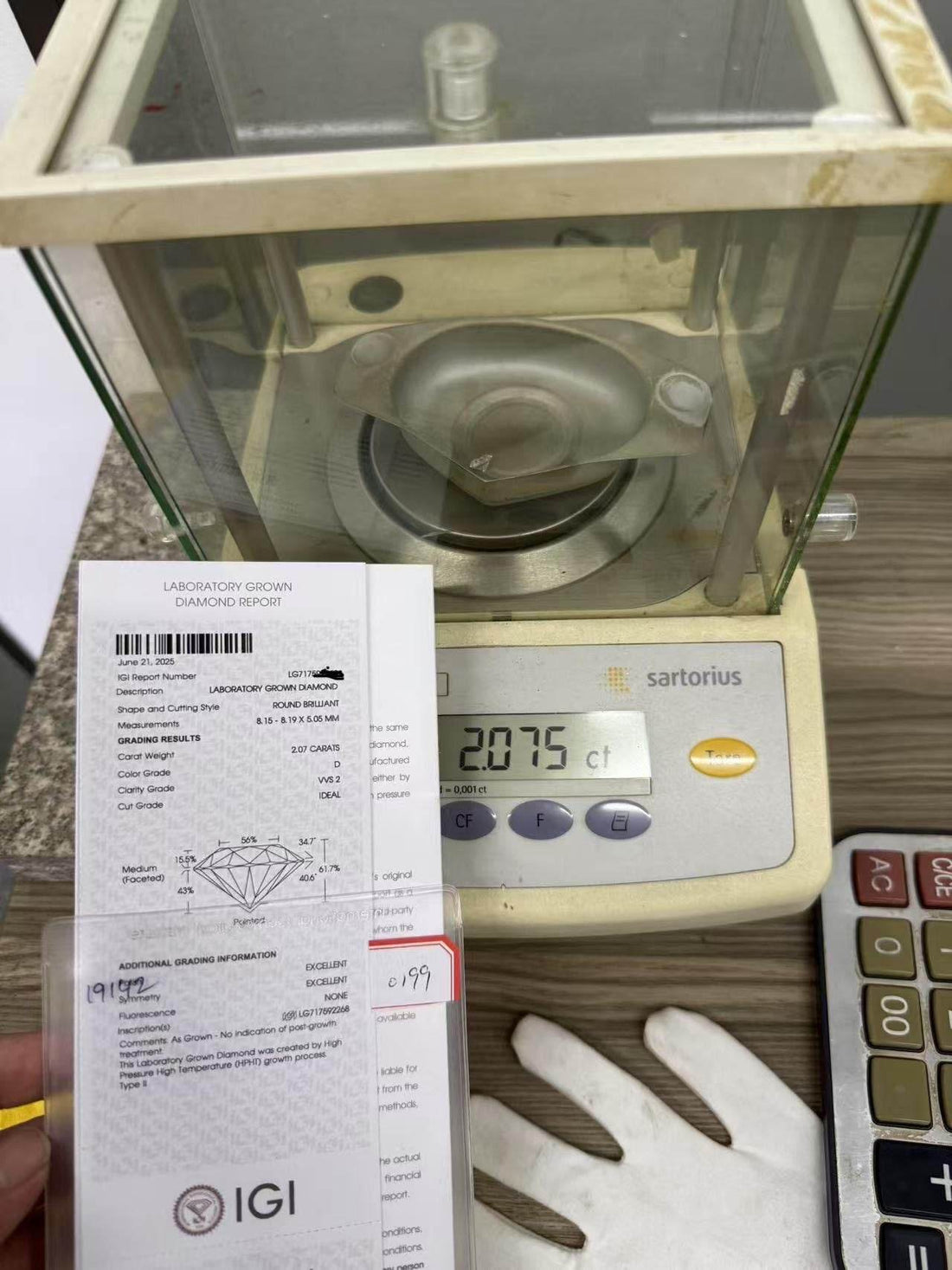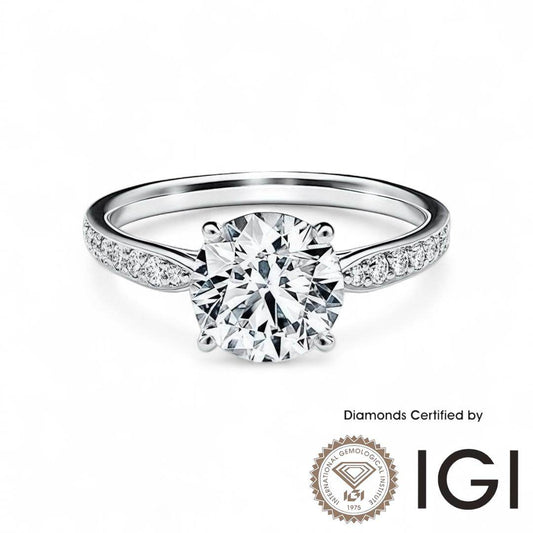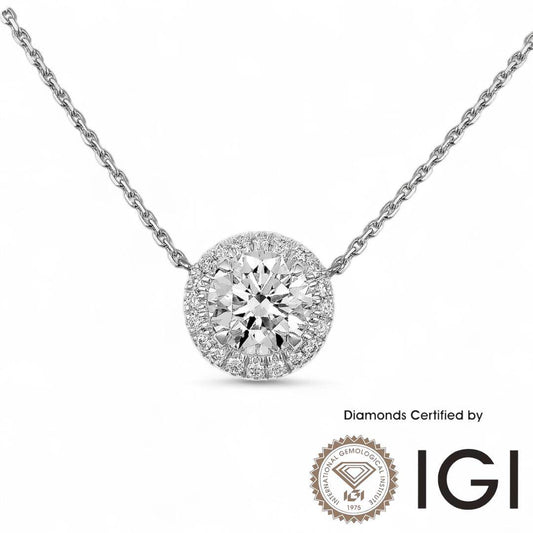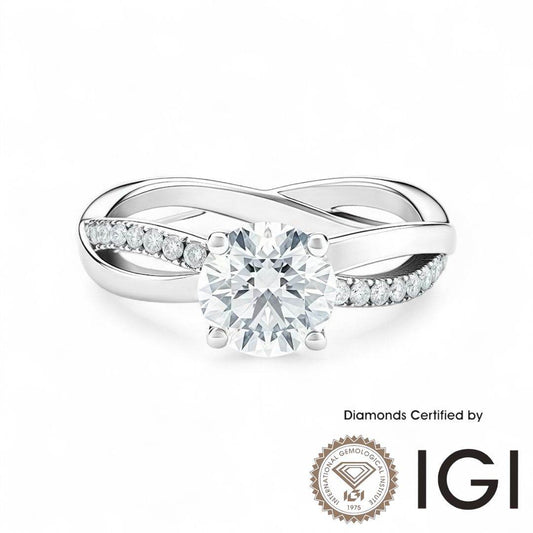Lab Grown Diamond 4C: Carat | Weight and Value Explained
Lab Grown Diamond 4C: Carat
What is Carat and Where Does it Come From?
The term carat (abbreviated ct) is the international standard unit for measuring gemstone weight. Many people mistakenly think that carat refers to the size or visual appearance of a diamond, but in reality, it only represents weight.
The word “carat” originates from the carob seed (kerátion in Greek). In ancient times, gem traders discovered that carob seeds had a remarkably consistent weight, making them ideal for use as counterweights on a balance scale. Over time, this unit of measurement became the standard for gemstones worldwide.
1 carat = 200 milligrams = 0.2 grams. Each carat is further divided into 100 points, so a 0.50-carat diamond is also called "50 points." Because diamond prices are extremely sensitive to small differences in weight, modern diamond scales measure weight to the thousandth of a carat and round to the nearest hundredth, e.g., 1.01 ct.
Lab Grown Diamond Carat and Price
Diamond price does not increase linearly with carat weight. For example, a 1.00-carat diamond is usually more expensive than two 0.50-carat diamonds of equivalent quality combined. This is because:
- Market psychology: Whole-number carat diamonds (1 ct, 2 ct, etc.) are more desirable, creating a price premium.
- Rarity: High-quality, large-carat diamonds are much rarer, so their prices increase exponentially with carat weight.
Additionally, natural diamonds and lab-grown diamonds differ in pricing trends:
- Natural diamonds: Prices increase sharply with carat weight.
- Lab-grown diamonds: Prices rise more gradually, offering better value for larger carat sizes.
Lab Grown Diamond Carat and Size
Carat refers to weight, not visual size. While there is some correlation between carat weight and diameter, the actual visual size depends heavily on the cut proportions.
For example, a 1-carat round diamond has an average diameter of about 6.3–6.5 mm. However, if the diamond is cut deep, the diameter may appear smaller, while a shallow cut may increase diameter but reduce brilliance.
The Importance of Table Percentage
The table is the largest flat surface on the top of a diamond, and the table percentage (Table %) = table width ÷ average diameter. Table percentage affects both perceived size and sparkle:
- Large Table (>60%): Makes the diamond appear bigger, but light reflection decreases, reducing brilliance.
- Small Table (<52%): Enhances sparkle, but the diamond looks smaller.
- Optimal Table Range: For round brilliant diamonds, 54–57% balances visual size and fire.
When buying a diamond, check the certificate (GIA, IGI) for Table %, Depth %, and cut grade, not just carat weight, to ensure ideal proportions.
Average Diameter Reference for Round Diamonds
| Carat Weight (ct) | Average Diameter (mm) |
|---|---|
| 0.25 ct | ≈ 4.1 mm |
| 0.50 ct | ≈ 5.2 mm |
| 0.75 ct | ≈ 5.9 mm |
| 1.00 ct | ≈ 6.4 mm |
| 1.50 ct | ≈ 7.4 mm |
| 2.00 ct | ≈ 8.1 mm |
| 3.00 ct | ≈ 9.3 mm |
Note: Actual diameters vary slightly depending on cut proportions.
MadisonDia, Lab Grown Diamond Experts: Buying Recommendations
- Do not focus solely on carat weight; consider cut and brilliance for the best visual appeal.
- Check certificate data, especially Table %, Depth %, and cut grade.
- With a limited budget, consider 0.80–0.95 ct diamonds, which often appear similar to 1 ct diamonds visually but cost less.
- Understand that weight ≠ size to avoid overpaying for visual impact.
Conclusion
Carat is a key factor in diamond evaluation, but it only represents weight, not visual size. When selecting a diamond, consider carat along with cut, table percentage, and brilliance to find a diamond that balances weight, beauty, and value.
you may visit IGI explanation with diamond carat: IGI Carat
Lab Grown Diamond Carat FAQ
Q: What is a diamond carat? A: A carat (ct) is a unit of weight, not size. One carat is equal to 200 milligrams or 0.2 grams.
Q: Does a larger carat weight always mean a larger-looking diamond? A: Not necessarily. While carat weight and visual size are correlated, a diamond's cut—specifically the table percentage—plays a significant role in how large the diamond appears and how much brilliance it has. A well-cut diamond can appear larger and more brilliant than a poorly cut one of the same carat weight.
Q: How does a diamond's carat weight relate to its value? A: The price of a diamond does not increase in a straight line with its carat weight. A single larger diamond is typically more expensive than two smaller diamonds of the same combined weight. This is due to market rarity and psychological factors.
Q: Are there differences in the pricing of natural vs. lab-grown diamonds based on carat weight? A: Yes. According to the article, the price of lab-grown diamonds increases more gradually with carat weight compared to natural diamonds. This means that larger lab-grown diamonds often offer better value.
Q: What should I consider besides carat weight when buying a diamond? A: To get the best balance of weight, beauty, and value, you should consider the diamond's cut grade, table percentage, and depth percentage, which can be found on a certification report (like GIA or IGI). Focusing only on carat weight may result in a diamond that lacks brilliance.
Author Bio— Winston Wu, Marketing Directors of Kardias Fashion Group, has focused on luxury procurement since 2012, deeply collaborating with European first-tier brands such as Versace, Moschino, Hugo Boss, and Roberto Cavalli, with rich practical experience in the diamond market.
Publication Date: 20 August 2025 Last Updated: 4 September 2025
Disclaimer: The price information provided in this article is based on January 2025 market data. Actual prices may vary due to market fluctuations. Please confirm the latest quotes with vendors before purchasing. This article does not constitute investment advice.
This article is jointly published by Luxury Boutique Madison Avenue





